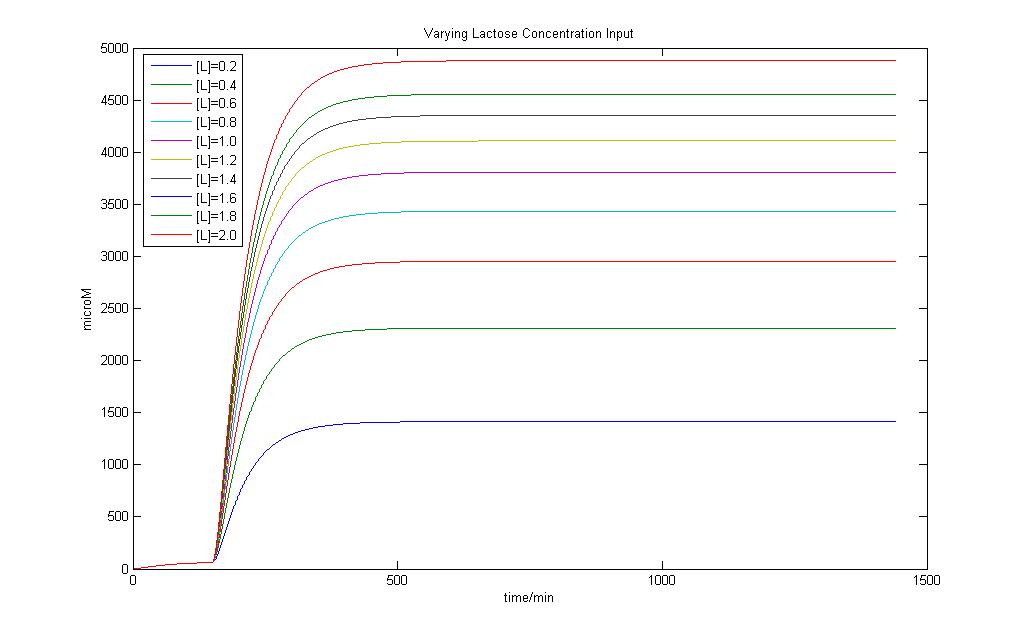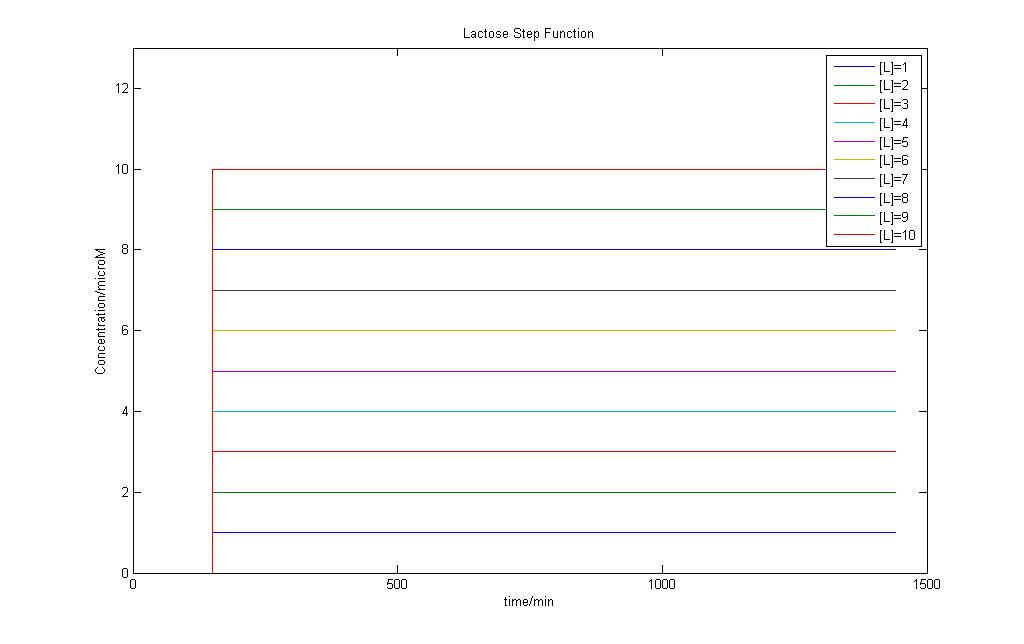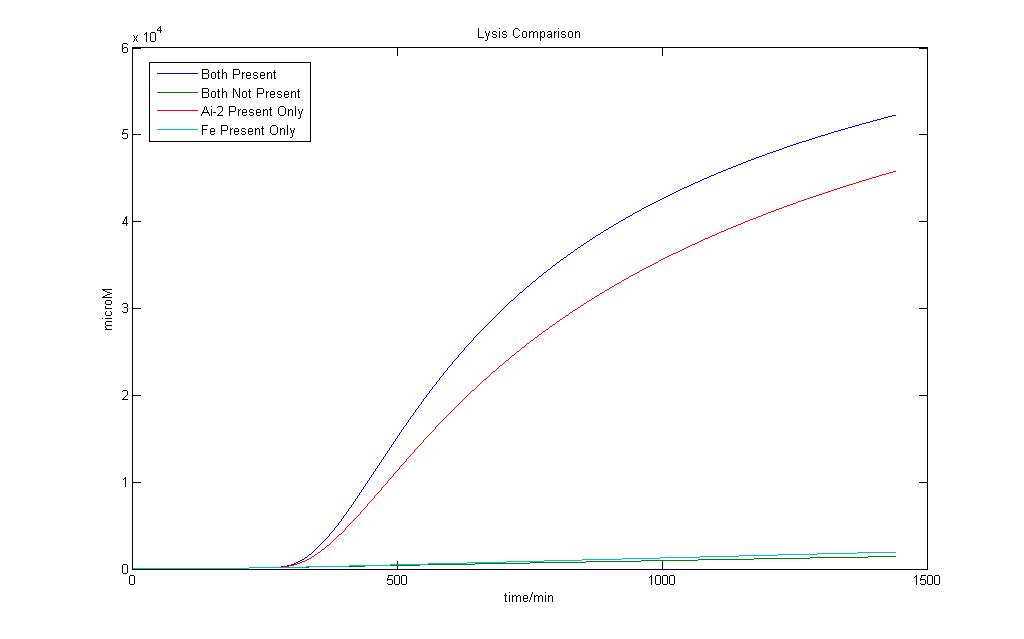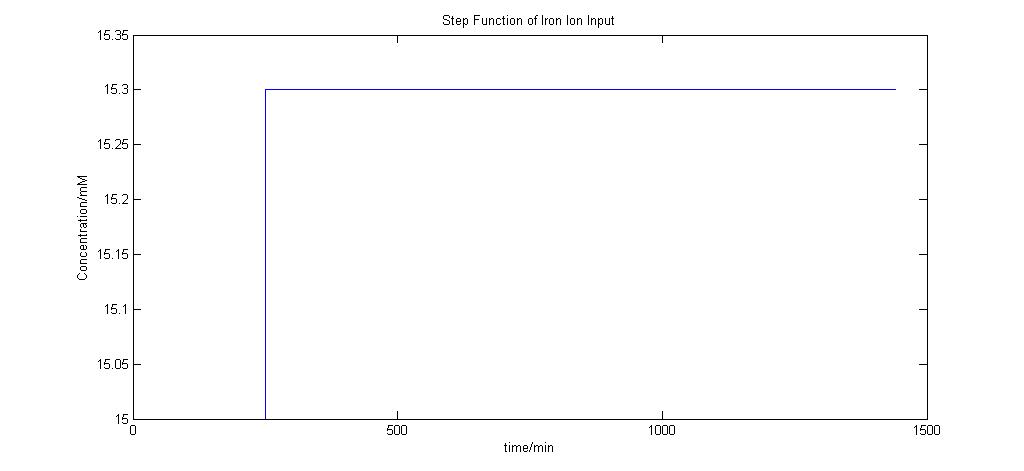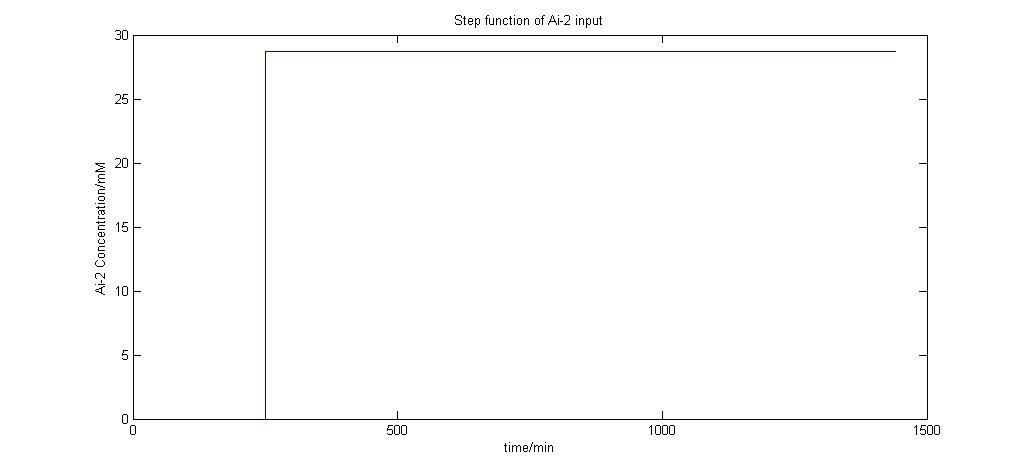Team:NTU-Singapore/Modelling/Deterministic Modeling
From 2008.igem.org
Lalala8585 (Talk | contribs) |
Lalala8585 (Talk | contribs) |
||
| Line 10: | Line 10: | ||
==E7 production system== | ==E7 production system== | ||
| - | The goal of this model is to predict the dynamic response of the E7 production system and to see how a change in the Lactose Input | + | The goal of this model is to predict the dynamic response of the E7 production system and to see how a change in the Lactose Input would affect the way the cell responses and the speed and shape of response. <br> |
'''Assumptions:'''<br> | '''Assumptions:'''<br> | ||
| Line 23: | Line 23: | ||
'''Analysis:''' <br> | '''Analysis:''' <br> | ||
| - | Modeling of the System shows that Lactose induction is essential to produce E7 and a variation of Lactose input can result in different yields of E7. As seen in the figures above, the concentration of E7 produced increases | + | Modeling of the System shows that Lactose induction is essential to produce E7 and a variation of Lactose input can result in different yields of E7. As seen in the figures above, the concentration of E7 produced increases until it reaches a final value without any oscillations. the profile of the response has a sigmoidal or "S" shape witha derivative that goes through a maximum at an inflection point and reduces to zero at the steady state value. It is also observed that the production of E7 begins almost instantaenously upon the addition of Lactose and the system possess no momentum. |
| + | |||
| + | The modeling exercise has confirmed that the lactose input would have an impact on the system's production of E7 and that the impact is certainly significant. | ||
==Lysis Production system== | ==Lysis Production system== | ||
| + | The goal of this model is to predict the dynamic response of the Lysis protein production system. There are two kinds of inputs in this system, Ai-2 and Iron ions. The response to the system under 4 different conditions would be examined and they are: <br> | ||
| + | ''1)Both Inputs are Present'' <br> | ||
| + | ''2)Both Inputs are Not Present'' <br> | ||
| + | ''3)Only the Ai-2 input is present'' <br> | ||
| + | ''4)Only the Fe ion input is present'' <br> | ||
| + | |||
| + | '''Assumptions:'''<br> | ||
| + | 1) The cell behaves like a well-mixed vessel or reactor.<br> | ||
| + | 2) Lactose input into the cell is constant and well-distributed. <br> | ||
| + | 3) The temperature and other conditions such as fluid medium concentrations remain constant throughout the time period. <br> | ||
| + | |||
| + | '''Results:'''<br> | ||
[[Image:Lysis.jpg|850px| Lysis Production Model]] | [[Image:Lysis.jpg|850px| Lysis Production Model]] | ||
[[Image:Varying_Lysis.jpg|850px|Lysis Prodcution Modeling Results]] | [[Image:Varying_Lysis.jpg|850px|Lysis Prodcution Modeling Results]] | ||
| Line 31: | Line 45: | ||
[[Image:Ai-2_Step_function.jpg |850px| Ai-2 Step Function]] | [[Image:Ai-2_Step_function.jpg |850px| Ai-2 Step Function]] | ||
| + | |||
| + | '''Analysis:''' <br> | ||
Here we define 1 as a certain threshold e.g. (<250 µM) that when the lysis protein reaches it, lysis in the cell definitely occurs. | Here we define 1 as a certain threshold e.g. (<250 µM) that when the lysis protein reaches it, lysis in the cell definitely occurs. | ||
| - | Although we wish for an absolute AND gate, where 0 will have no lysis production at all, simulation on biological systems shows that such results are impossible. | + | Although we wish for an absolute AND gate, where 0 will have no lysis production at all, simulation on biological systems shows that such results are impossible. We cna observe that for the response, it is a sigmoidal response that does not taper off to a steady state value even after the time period has been extended for 1440 min. It is also observed that the response of the system to any input seems to take a while before the actual production begins. We can infer that the phosphorylations processes and AND gate within the system all takes time to process before the Lysis protein is produced. |
| - | + | Both addition Fe ions and Ai-2 alone would induce a certain level of lysis production. However when both are available, the lysis protein production would be higher. In the presence of Ai-2 alone, Lysis will most likely still occur albeit at a slower rate compared to situation when both Fe and Ai-2 are present. With the addition of iron and Ai-2 together the rate of lysis production is still significantly much higher compared to Ai-2 alone. | |
| - | In the presence of Ai-2 alone, Lysis will most likely still occur albeit at a slower rate compared to situation when both Fe and Ai-2 are present. | + | |
| - | + | ||
| - | With the addition of iron and Ai-2 together the rate of lysis production is still significantly much higher compared to Ai-2 alone. | + | |
Therefore, by giving the logical output ‘1’ as a suitable threshold value of Lysis protein production higher than that of Ai-2 induction alone, we would still be able to obtain an AND gate based on our definition. | Therefore, by giving the logical output ‘1’ as a suitable threshold value of Lysis protein production higher than that of Ai-2 induction alone, we would still be able to obtain an AND gate based on our definition. | ||
| + | |||
| + | The model also gives us the warning that the Lysis production system may not be as fast to respond to the inputs as we desire. There in lies the compromise that if we wish for a very fast Lysis protein production response, we might have to sacrifice the specificity that an AND gate system may provide. | ||
=Updates= | =Updates= | ||
</div> | </div> | ||
Revision as of 05:53, 17 August 2008
|
Contents |
Deterministic Models
From the previous exercises on choosing suitable parameters and ODEs for our models, we have produced some simple models for our systems. The models are all generated using [http://www.mathworks.com/products/simulink/ SIMULINK]. Simulink has proven to be very useful in controlling variable inputs and it allows dynamic modeling. The user interface is friendly and easy to use.
E7 production system
The goal of this model is to predict the dynamic response of the E7 production system and to see how a change in the Lactose Input would affect the way the cell responses and the speed and shape of response.
Assumptions:
1) The cell behaves like a well-mixed vessel or reactor.
2) Lactose input into the cell is constant and well-distributed.
3) The temperature and other conditions such as fluid medium concentrations remain constant throughout the time period.
Analysis:
Modeling of the System shows that Lactose induction is essential to produce E7 and a variation of Lactose input can result in different yields of E7. As seen in the figures above, the concentration of E7 produced increases until it reaches a final value without any oscillations. the profile of the response has a sigmoidal or "S" shape witha derivative that goes through a maximum at an inflection point and reduces to zero at the steady state value. It is also observed that the production of E7 begins almost instantaenously upon the addition of Lactose and the system possess no momentum.
The modeling exercise has confirmed that the lactose input would have an impact on the system's production of E7 and that the impact is certainly significant.
Lysis Production system
The goal of this model is to predict the dynamic response of the Lysis protein production system. There are two kinds of inputs in this system, Ai-2 and Iron ions. The response to the system under 4 different conditions would be examined and they are:
1)Both Inputs are Present
2)Both Inputs are Not Present
3)Only the Ai-2 input is present
4)Only the Fe ion input is present
Assumptions:
1) The cell behaves like a well-mixed vessel or reactor.
2) Lactose input into the cell is constant and well-distributed.
3) The temperature and other conditions such as fluid medium concentrations remain constant throughout the time period.
Analysis:
Here we define 1 as a certain threshold e.g. (<250 µM) that when the lysis protein reaches it, lysis in the cell definitely occurs.
Although we wish for an absolute AND gate, where 0 will have no lysis production at all, simulation on biological systems shows that such results are impossible. We cna observe that for the response, it is a sigmoidal response that does not taper off to a steady state value even after the time period has been extended for 1440 min. It is also observed that the response of the system to any input seems to take a while before the actual production begins. We can infer that the phosphorylations processes and AND gate within the system all takes time to process before the Lysis protein is produced.
Both addition Fe ions and Ai-2 alone would induce a certain level of lysis production. However when both are available, the lysis protein production would be higher. In the presence of Ai-2 alone, Lysis will most likely still occur albeit at a slower rate compared to situation when both Fe and Ai-2 are present. With the addition of iron and Ai-2 together the rate of lysis production is still significantly much higher compared to Ai-2 alone.
Therefore, by giving the logical output ‘1’ as a suitable threshold value of Lysis protein production higher than that of Ai-2 induction alone, we would still be able to obtain an AND gate based on our definition.
The model also gives us the warning that the Lysis production system may not be as fast to respond to the inputs as we desire. There in lies the compromise that if we wish for a very fast Lysis protein production response, we might have to sacrifice the specificity that an AND gate system may provide.
 "
"


